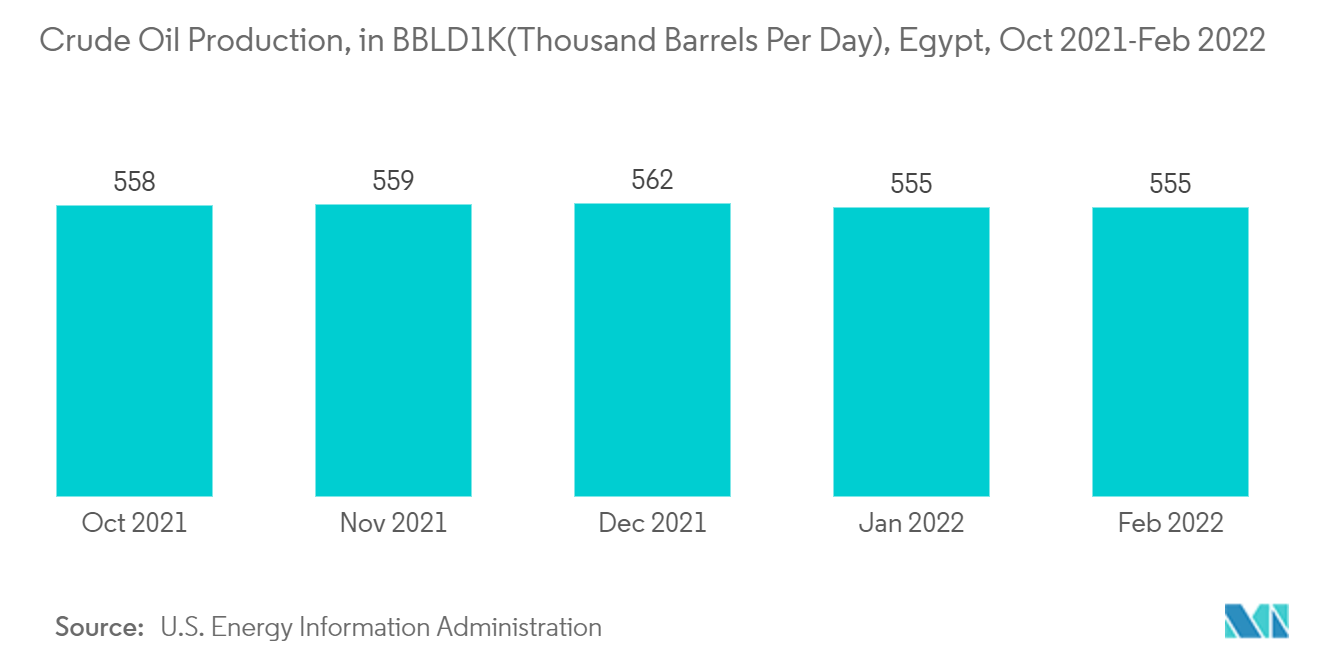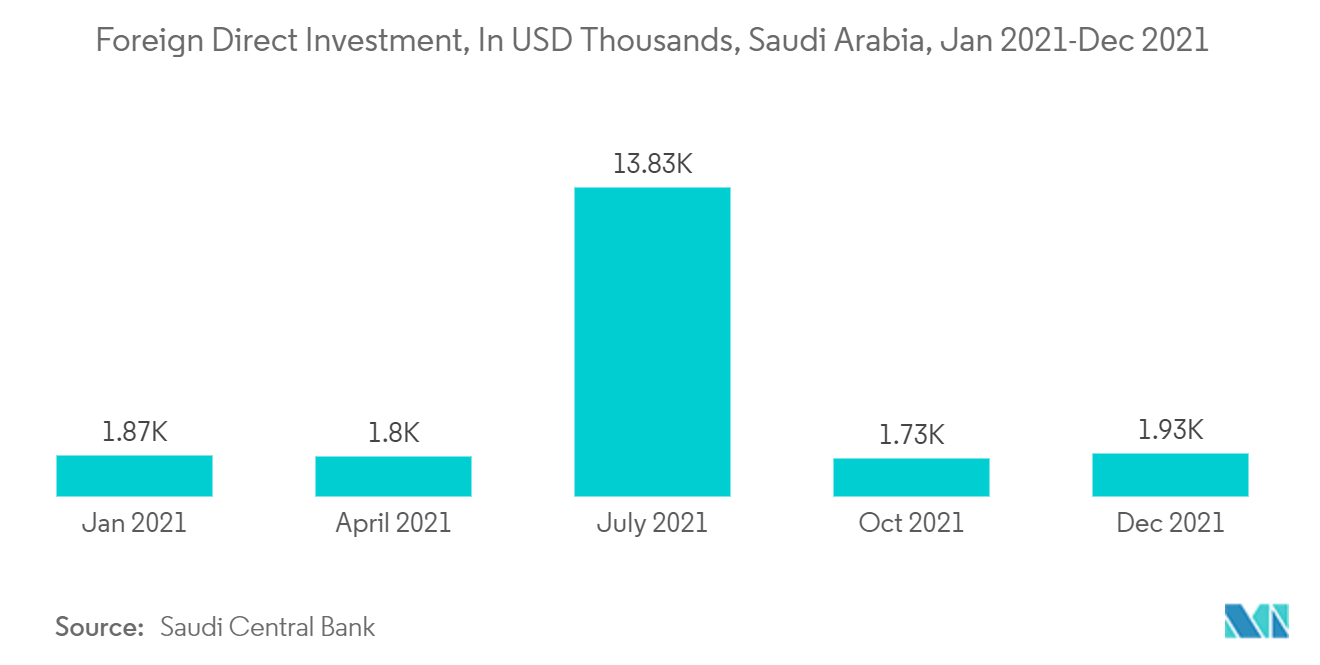Market Trends of Middle East & Africa Variable Frequency Drive (VFD) Industry
This section covers the major market trends shaping the MEA Variable Frequency Drive (VFD) Market according to our research experts:
The Oil and Gas Segment is Expected to Drive the Market's Growth
- The Middle Eastern region is a significant oil-producing region in the world. According to the Organization of the Petroleum Exporting Countries, Saudi Arabia possesses around 17% of the world's proven petroleum reserves. The oil and gas sector accounts for about 50% of gross domestic product and about 70% of export earnings. Apart from petroleum, the Kingdom's other natural resources include natural gas, iron ore, gold, and copper. Further, according to Energy Information Administration, Saudi Arabia holds 15% of the world's proven oil reserves. It is the largest exporter of crude oil in the world and holds the world's largest crude oil production capacity at approximately 12 million barrels per day, including capacity from the Neutral Zone that is shared with Kuwait. Saudi Arabia is the largest crude oil producer in OPEC and the second-largest total petroleum liquids producer in the world after the United States. The extensive oil production calls for efficient VFDs for the seamless functioning of the sector.
- In the oil and gas sector, low voltage drives are used mainly in upstream applications, such as hydraulic fracturing skids and offshore rigs and FPSOs (Floating Production Storage and Offloading). Medium voltage drives are used mainly for power applications in midstream and LNG subsectors, like for natural gas compression and liquefaction and to operate larger pumps. Strengthening offshore oil and gas operations is expected to increase demand for low voltage drives over the forecast period.
- In the recent time, owing to the fluctuations in the oil market caused by an oversupply of crude oil in the global market and low prices, several countries in the region, especially Middle-East have been increasing their investments in the manufacturing sector and Industry 4.0 concepts to reduce their dependency on the oil and gas sector.
- Further, the landscape of the Middle East oil & gas industry in the past few years has mirrored global trends and has experienced both challenges and changes. Investment across the region has become more diverse, and new avenues are being discovered, such as LNG and more complex offshore projects. As per the Arab Petroleum Investments Corporation (APICORP), a multilateral development financial institution, the overall planned and committed investments in the MENA region will exceed USD 805 billion from 2021 to 2025, a USD 13 billion increase from the USD 792 billion estimates in previous year's five-year outlook.
- The investment upsurge in the coming years will be driven by new drilling contracts, licensing awards, and future bid rounds, thus, likely to spur the VFD industry growth. For instance, recently, Zadcois has been looking to increase production from the field from 750,000 b/d to around 1 million b/d by 2024 by drilling additional wells using extended-reach drilling and maximum reservoir contact well technologies.

Increasing Investments in Various End-user Industries is Expected to Boost the Market Growth
- The regional companies are investing to increase production capacity, which may drive the studied market. For Instance, in March 2022, Saudi Arabia's state oil giant, Aramco, announced to increase spending by approximately 50% this 2022 as it reported a tripling in 2021 profits, despite demands from the West to increase output amid high prices. Last year, Saudi Aramco benefited from a more than 50% increase in oil prices, as demand outpaced supply due to rising COVID-19 immunization rates and loosening restrictions. Aramco has stated that it plans to increase capital expenditures (CAPEX) to USD 40-50 billion this year, with further rise likely until the middle of the decade.
- The country adopts international standards while treating sewage. Additionally, the advent of new treatment plants due to the ongoing trend of sewage treatment is expected to drive the demand for VFDs. Water scarcity is one of the major problems in the region.
- The UAE Water Security Strategy 2036 was unveiled in September 2017 by the Ministry of Energy and Infrastructure to ensure sustainable access to water in both standard and emergencies, in accordance with local regulations, World Health Organization standards, and the UAE's vision of prosperity and sustainability. The strategy's overall goals aimed to reduce the total demand for water resources by 21%, raise the water productivity index to USD 110 per cubic meter, reduce water scarcity by three degrees, boost treated water reuse to 95%, and expand national water storage capacity to two days.
- Variable frequency drives are also an attractive energy management investment for the infrastructure sector. For Instance, according to King Abdullah Petroleum Studies and Research Center, in the UAE, buildings consume almost 90% of the total electricity used in the country, mostly in Dubai and Abu Dhabi. Most of the newly constructed UAE buildings must comply with certain energy efficiency requirements under the mandatory regulations of the building rating systems applied in Abu Dhabi and Dubai (such as the Green Building Regulations). Thus, to improve the energy efficiency of the building, DEWA (Dubai Electricity and Water Authority) created Etihad Energy Services (EES) in 2013. The primary goal of the EES is to achieve 1.7 TWh in energy savings from building retrofits by 2030.
- In May 2022, The Saudi Arabian Ministry of Industry and Mineral Resources announced plans to seek USD 32 billion in mining and minerals investments. The country wants to assist the development of nine mining projects for midstream minerals and metals as part of the plan to boost mineral exports. According to Saudi Arabia's Minister of Industry and Mineral Resources, Bandar bin al-Khorayef, the government is now constructing a steel plate plant worth more than USD 4 billion and a USD 2 billion factories for electric car battery input of this investment plan.

